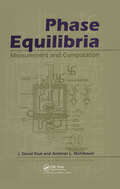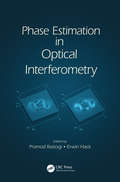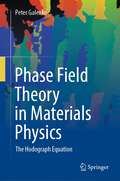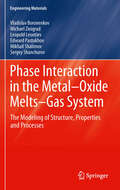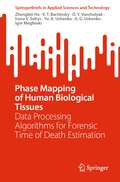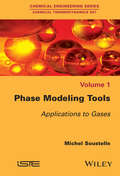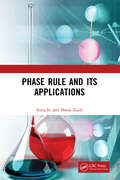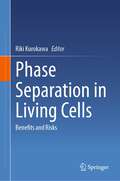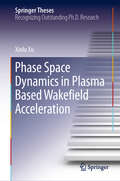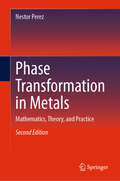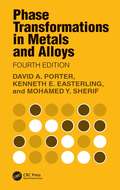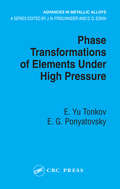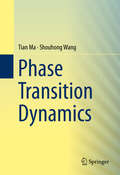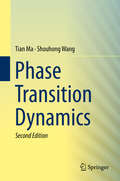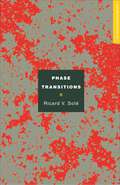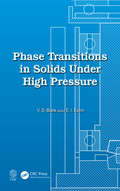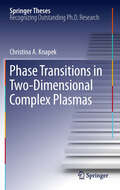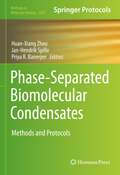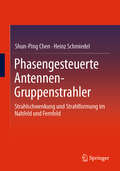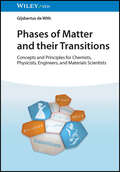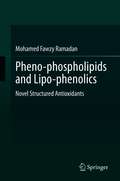- Table View
- List View
Phase Equilibria: Measurement & Computation
by Andreas L. Muhlbauer J. David RaalThis work provides coverage of experimental and theoretical procedures for vapour-liquid equilibria (VLE). A survey of the different models and approaches in recent literature enables the reader to choose the appropriate action.
Phase Estimation in Optical Interferometry
by Pramod Rastogi Erwin HackThis book covers the essentials of phase-stepping algorithms used in interferometry and pseudointerferometric techniques. It presents the basic concepts and mathematics needed for understanding modern phase estimation methods. The book first focuses on phase retrieval from image transforms using a single frame. It then examines the local environment of a fringe pattern, the phase estimation approach based on local polynomial phase modeling, temporal high-resolution phase evaluation methods, and methods of phase unwrapping. It also discusses experimental imperfections liable to adversely influence the accuracy of phase measurements.
Phase Field Theory in Materials Physics: The Hodograph Equation
by Peter GalenkoThis book deals with the use of the hodograph equation in phase transformations in condensed matter, especially, for crystallization and solidification processes. The main focus of the book is the interpretation of the phase-field equations for isotropic and anisotropic interfaces based on the advanced Gibbs–Thomson and Herring conditions, respectively. Beginning with the basic ideas behind the extended irreversible thermodynamics, the kinetic phase-field model for slow and arbitrarily fast phase transformations is derived where the unified hodograph equation follows from:• the sharp interface limit of the diffuse interface or• the traveling wave solution of the propagating phase field.Under the example of solute trapping and disorder trapping effects, comparing theoretical results with molecular dynamics simulations, and with the analysis of experimental data, the concrete workability of the developed hodograph equation is demonstrated for widest range of driving force in phase transformations.
Phase Interaction in the Metal - Oxide Melts - Gas -System
by Mikhail Shalimov Michael Zinigrad Vladislav Boronenkov Edward Pastukhov Leopold Leontiev Sergey ShanchurovThis monograph describes mathematical models that enable prediction of phase compositions for various technological processes, as developed on the base of a complex physico-chemical analysis of reaction. It studies thermodynamics and kinetics of specific stages of complex pyrometallurgical processes involving boron, carbon, sulfur, tungsten, phosphorus, and many more, as well as their exposure to all sorts of factors. First and foremost, this enables to optimize processes and technologies at the stage of design, while traditional empirical means of development of new technologies are basically incapable of providing an optimal solution. Simulation results of metals and alloys production, welding and coating technologies allow obtaining materials with pre-given composition, structure and properties in a cost-saving and conscious manner. Moreover, a so-called "inverse problem", i.e., selecting source materials which would ensure the required results, cannot be solved by any other means.
Phase Mapping of Human Biological Tissues: Data Processing Algorithms for Forensic Time of Death Estimation (SpringerBriefs in Applied Sciences and Technology)
by A. G. Ushenko Yu. A. Ushenko Igor Meglinski Zhengbin Hu Iryna V. Soltys V. T. Bachinsky O. Y. VanchulyakThis book presents numerical computer-aided smart-methods as part of a comprehensive statistical, correlation and fractal analysis of laser polarimetry data. It highlights relationships between polarization (azimuth distributions, polarization ellipticities, Stokes vector parameters, Mueller matrix elements) parameters of laser images of biological tissues of a human corpse in different spectral ranges and temporal dynamics of their postmortem morphological changes. The book discusses the effectiveness of correlation analysis of two-dimensional distributions of polarization inhomogeneous images of histological sections of the main types of biological tissues in determining the time of death. It also discusses the development of basic principles of phase measurements (phasometry) of microscopic images of biological tissues to determine the age of death and the time of hematoma formation. Also presented in the book are possibilities of complex laser spectral photopolarimetry images of histological sections of biological tissues of human corpse in different spectral regions, with the simultaneous development and substantiation of a set of statistical and correlational criteria for objective determination of the time of death.
Phase Modeling Tools
by Michel SoustelleThis book is part of a set of books which offers advanced students successive characterization tool phases, the study of all types of phase (liquid, gas and solid, pure or multi-component), process engineering, chemical and electrochemical equilibria, and the properties of surfaces and phases of small sizes. Macroscopic and microscopic models are in turn covered with a constant correlation between the two scales. Particular attention has been given to the rigor of mathematical developments.
Phase Rule and Its Applications
by Suruchi Sheza ZaidiThe book covers the fundamental concepts of phases, phase diagrams and their applications. Stress is on understanding and not on memorization. The book has descriptive passages and diagrams (cooling curves) that help students gain a solid foundation in subject. This text will help them learn phase rule faster. It also contains numerous phase diagrams. Note: T& F does not sell or distribute the Hardback in India, Pakistan, Nepal, Bhutan, Bangladesh and Sri Lanka.
Phase Separation in Living Cells: Benefits and Risks
by Riki KurokawaThis book presents the latest cutting-edge research on phase separation. It discusses the benefits and risks of phase separation for living cells from the perspectives of physics, chemistry, biology, and medicine.Phase separation is a physico-chemical process that induces a single solution of solvent and intrinsically disordered proteins (IDPs) to separate into two phases, one phase containing only solvent and the other containing IDPs in the solvent. A key molecule in phase separation is the intrinsically disordered region (IDR) proteins (IDPs), mostly comprised of RNA-binding proteins (RBPs). One of the major roles of phase separation is to generate condensates, membrane-less organelles including stress granule, Cajal body, and nucleolus.Biological actions of phase separation in various aspects of science have received increasing attention in recent years. The book consists of four parts; Part I on physics and chemistry includes topics on structural biology of RBP FUS/TLS and chaperone for phase separation, computational approach of phase separation, and chemistry of G-quadruplex of DNA and RNA. Part II on molecular biology presents molecular mechanism of IDR sequence phase separation and potential cellular function of these labile fibers, formation of membrane-less organelles, and roles of noncoding RNAs in phase separation. Part III on biology covers topics from nuclear pore complex, developmental biology regarding force-dependent remodeling, and neurobiology and higher order brain functions. Finally, Part IV on medicine presents condensates and cancer therapy, pathogenesis of neurodegenerative diseases based on IDPs, and responses of microglia to amyloid. The last chapter highlights the latest topic on how the SARS-Cov-2 virus takes advantage of phase separation for its infections.This book brings together the studies of phase separation in each area in a single volume. The comprehensive approach provides new insights to the research and will benefit the readers by responding to the emerging needs for understanding phase separation.
Phase Space Dynamics in Plasma Based Wakefield Acceleration (Springer Theses)
by Xinlu XuThis book explores several key issues in beam phase space dynamics in plasma-based wakefield accelerators. It reveals the phase space dynamics of ionization-based injection methods by identifying two key phase mixing processes. Subsequently, the book proposes a two-color laser ionization injection scheme for generating high-quality beams, and assesses it using particle-in-cell (PIC) simulations. To eliminate emittance growth when the beam propagates between plasma accelerators and traditional accelerator components, a method using longitudinally tailored plasma structures as phase space matching components is proposed. Based on the aspects above, a preliminary design study on X-ray free-electron lasers driven by plasma accelerators is presented. Lastly, an important type of numerical noise—the numerical Cherenkov instabilities in particle-in-cell codes—is systematically studied.
Phase Transformation in Metals: Mathematics, Theory and Practice
by Nestor PerezThis textbook explains the physics of phase transformation and associated constraints from a metallurgical or materials science point of view, based on many topics including crystallography, mass transport by diffusion, thermodynamics, heat transfer and related temperature gradients, thermal deformation, and even fracture mechanics. The work presented emphasizes solidification and related analytical models based on heat transfer. This corresponds with the most fundamental physical event of continuous evolution of latent heat of fusion for directional or non-directional liquid-to-solid phase transformation at a specific interface with a certain geometrical shape, such as planar or curved front. Dr. Perez introduces mathematical and engineering approximation schemes for describing the phase transformation, mainly during solidification of pure metals and alloys. Giving clear definitions and explanations of theoretical concepts and full detail of derivation of formulae, this interdisciplinary volume is ideal for graduate and upper-level undergraduate students in applied science, and professionals in the metal making and surface reconstruction industries.
Phase Transformation in Metals: Mathematics, Theory, and Practice
by Nestor PerezThis new edition retains its class-tested explanation of the physics of phase transformation and associated constraints from a metallurgical/materials science point of view, and adds an enhanced treatment of the underlying theoretical concepts with greater clarification. The new edition continues its examination of crystallography, mass transport by diffusion, thermodynamics, heat transfer and related temperature gradients, thermal deformation, and even fracture mechanics. The work presented emphasizes solidification and related analytical models based on heat transfer. This corresponds with the most fundamental physical event of continuous evolution of latent heat of fusion for directional or non-directional liquid-to-solid phase transformation at a specific interface with a certain geometrical shape, such as planar or curved front. Dr. Perez introduces mathematical and engineering approximation schemes for describing the phase transformation, mainly during solidification of pure metals and alloys. Giving clear definitions and explanations of theoretical concepts and full detail of derivation of formulae, this interdisciplinary volume is ideal for graduate and upper-level undergraduate students in applied science, and professionals in the metal making and surface reconstruction industries.
Phase Transformations and Heat Treatments of Steels
by Bankim Chandra Ray Rajesh Kumar Prusty Deepak NayakThe perpetual flow of understanding between phase transformation that controls grain/microstructures and heat treatment which decides the size of grains/microstructures of steels is not well articulated in the perspective of undergraduate students. In Phase Transformations and Heat Treatments of Steels, theories of phase transformation have been used to obtain a desirable phase or combination of phases by performing appropriate heat treatment operations, leading to unification of both the concepts. Further, it includes special and critical heat treatment practices, case studies, local and in-service heat treatments, curative and preventive measures of heat treatment defects for several common and high-performance applications. Features: Presents fundamentals of phase transformation in steels Analyzes basics of phase transformation due to heat treatment of steel under various environmental conditions Explains application of heat treatment for different structural components Discusses heat treatment defects and detection Emphasizes heat treatment of special steels and in-situ heat treatment practices
Phase Transformations in Metals and Alloys
by David A. Porter Kenneth E. Easterling Mohamed Y. SherifRevised to reflect recent developments in the field, Phase Transformation in Metals and Alloys, Fourth Edition, continues to be the most authoritative and approachable resource on the subject. It supplies a comprehensive overview of specific types of phase transformations, supplemented by practical case studies of engineering alloys. The book’s unique presentation links a basic understanding of theory with application in a gradually progressive yet exciting manner. Based on the authors’ teaching notes, the text takes a pedagogical approach and provides examples for applications and problems that can be readily used for exercises. NEW IN THE FOURTH EDITION 40% of the figures and 30% of the text Insights provided by numerical modelling techniques such as ab initio, phase field, cellular automaton, and molecular dynamics Insights from the application of advanced experimental techniques, such as high-energy X-ray diffraction, high-resolution transmission electron microscopy, scanning electron microscopy, combined with electron backscattered diffraction New treatment of ternary phase diagrams and solubility products The concept of paraequilibrium in systems containing highly mobile interstitial elements Thermodynamics of grain boundaries and the influence of segregation on grain boundary diffusion Reference to software tools for solving diffusion problems in multicomponent systems Introduction to concepts related to coincident site lattices and methods for determining the dislocation content of grain boundaries and interfaces Updated treatment of coherency and interface structure including the important fcc–bcc interfaces Treatment of metallic glasses expanded to cover critical cooling rate Austin–Rickets equation introduced as an alternative to the Avrami equation in the case of precipitation kinetics Discussion of the effects of overlap in nucleation, growth and coarsening Discussion of pearlite and bainite transformations updated Entirely new and extensive treatment of diffusionless martensitic transformations covering athermal and thermally activated martensite in ferrous systems as well as shape memory, superelasticity and rubber-like behavior in ordered nonferrous alloys New practical applications covering spinodal alloys, fir-tree structures in aluminum castings, Al–Cu–Li aerospace alloys, superelastic and shape memory alloys, quenched and partitioned steels, advanced high-strength steels and martensitic stainless steels Each chapter now concludes with a summary of the main points References to scientific publications and suggestions for further reading updated to reflect experimental and computational advances Aimed at students studying metallurgy and materials science and engineering, the Fourth Edition retains the previous editions’ popular easy-to-follow style and excellent mix of basic and advanced information, making it ideal for those who are new to the field. A new solutions manual and PowerPoint figure slides are available to adopting professors.
Phase Transformations of Elements Under High Pressure (Advances in Metallic Alloys)
by E. Yu Tonkov E.G. PonyatovskyAs laboratories replace heavy hydraulic presses and bulky high-pressure chambers with miniature diamond anvils, traditional heaters with laser heating, and continue to improve methods of shock compression, there has been considerable new data obtained from the high-pressure, high-temperature modification of pure elements. The dense metallic modification of elements shows the potential for achieving superconductivity akin to theoretical predictions.Phase Transformations of Elements Under High Pressure contains the latest theoretical and experimental information on nearly 100 elements, including first-and second-phase transitions, melting lines, crystal structures of stable and metastable phases, stability of polymorphic modifications, and other useful properties and data. It emphasizes features such as changes in the liquid state, amorphization, and metallization, and provides temperature-pressure diagrams for every element. The book also describes the transitions of polymeric forms of fullerene, crystal modifications of elements stable under high pressures, and provides data that confirms their superconducting and magnetic properties.This handbook will be a lasting reference for scientists in a broad range of disciplines, including solid-state physics, chemistry, crystallography, mineralogy, and materials science.
Phase Transition Dynamics
by Shouhong Wang Tian MaThis book is an introduction to a comprehensive and unified dynamic transition theory for dissipative systems and to applications of the theory to a range of problems in the nonlinear sciences. The main objectives of this book are to introduce a general principle of dynamic transitions for dissipative systems, to establish a systematic dynamic transition theory, and to explore the physical implications of applications of the theory to a range of problems in the nonlinear sciences. The basic philosophy of the theory is to search for a complete set of transition states, and the general principle states that dynamic transitions of all dissipative systems can be classified into three categories: continuous, catastrophic and random. The audience for this book includes advanced graduate students and researchers in mathematics and physics as well as in other related fields.
Phase Transition Dynamics
by Shouhong Wang Tian MaThis book is an introduction to a comprehensive and unified dynamic transition theory for dissipative systems and to applications of the theory to a range of problems in the nonlinear sciences. The main objectives of this book are to introduce a general principle of dynamic transitions for dissipative systems, to establish a systematic dynamic transition theory, and to explore the physical implications of applications of the theory to a range of problems in the nonlinear sciences. The basic philosophy of the theory is to search for a complete set of transition states, and the general principle states that dynamic transitions of all dissipative systems can be classified into three categories: continuous, catastrophic and random. The audience for this book includes advanced graduate students and researchers in mathematics and physics as well as in other related fields.This second edition introduces a unified theory for topological phase transitions, provides a first-principle approach to statistical and quantum physics, and offers a microscopic mechanism of quantum condensates (Bose-Einstein condensation, superfluidity, and superconductivity). Reviews of first edition: “The goals of this interesting book are to derive a general principle of dynamic transitions for dissipative systems and to establish a systematic dynamic transition theory for a wide range of problems in the nonlinear sciences. … The intended audience for this book includes students and researchers working on nonlinear problems in physics, meteorology, oceanography, biology, chemistry, and the social sciences.” (Carlo Bianca, Mathematical Reviews, December, 2014) “This is a clearly written book on numerous types of phase transitions taken in a broad sense when a dynamical dissipative system transforms from one physical state into another. … The book is a very useful literature not only for the professionals in the field of dynamic systems and phase transitions but also for graduate students due to its interdisciplinary coverage and state-of-the-art level.” (Vladimir Čadež, zbMATH, Vol. 1285, 2014)
Phase Transitions (Primers in Complex Systems #3)
by Ricard SoléPhase transitions--changes between different states of organization in a complex system--have long helped to explain physics concepts, such as why water freezes into a solid or boils to become a gas. How might phase transitions shed light on important problems in biological and ecological complex systems? Exploring the origins and implications of sudden changes in nature and society, Phase Transitions examines different dynamical behaviors in a broad range of complex systems. Using a compelling set of examples, from gene networks and ant colonies to human language and the degradation of diverse ecosystems, the book illustrates the power of simple models to reveal how phase transitions occur. Introductory chapters provide the critical concepts and the simplest mathematical techniques required to study phase transitions. In a series of example-driven chapters, Ricard Solé shows how such concepts and techniques can be applied to the analysis and prediction of complex system behavior, including the origins of life, viral replication, epidemics, language evolution, and the emergence and breakdown of societies. Written at an undergraduate mathematical level, this book provides the essential theoretical tools and foundations required to develop basic models to explain collective phase transitions for a wide variety of ecosystems.
Phase Transitions in Materials
by Brent FultzOffering a fresh viewpoint on phase changes and the thermodynamics of materials, this textbook covers the thermodynamics and kinetics of the most important phase transitions in materials science, spanning classical metallurgy through to nanoscience and quantum phase transitions. Clear, concise and complete explanations rigorously address transitions from the atomic scale up, providing the quantitative concepts, analytical tools and methods needed to understand modern research in materials science. Topics are grouped according to complexity, ensuring that students have a solid grounding in core topics before they begin to tackle more advanced material, and are accompanied by numerous end-of-chapter problems. With explanations firmly rooted in the context of modern advances in electronic structure and statistical mechanics, and developed from classroom teaching, this book is the ideal companion for graduate students and researchers in materials science, condensed matter physics, solid state science, and physical chemistry.
Phase Transitions in Solids Under High Pressure
by Vladimir Davydovich Blank Emmanuel Isakovich EstrinThe use of high-pressure techniques has become popular for studying the nature of substances and phenomena occurring in them, especially as a means of obtaining new materials (synthesis under high pressure) and processing known materials (hydroextrusion). A product of many years of research by the authors and their colleagues, Phase Transitions in
Phase Transitions in Two-Dimensional Complex Plasmas
by Christina A. KnapekThe two experimental studies reported in this thesis contribute important new knowledge about phase transitions in two-dimensional complex plasmas: in one case a determination of the coupling parameter (ratio of mean potential to mean kinetic energy of the particles in an ensemble), and in the other a detailed characterization of the non-equilibrium recrystallization of a two-dimensional system. The latter results are used to establish the connection between structural order parameters and the kinetic energy, which in turn gives novel insights into the underlying physical processes determining the two-dimensional phase transition.
Phase-Separated Biomolecular Condensates: Methods and Protocols (Methods in Molecular Biology #2563)
by Huan-Xiang Zhou Jan-Hendrik Spille Priya R. BanerjeeThis volume provides readers with a broad collection of theoretical, computational, and experimental methods to quantitatively study the properties of phase-separate biomolecular condensates in diverse systems. The chapters in this book cover topics such as theoretical and computational methods; methods for in vitro characterization of biomolecular condensates; and techniques that enable in-cell characterization of biomolecular condensates. Written in the highly successful Methods in Molecular Biology series format, chapters include introduction to their respective topics, lists of the necessary materials and reagents, step-by-step, readily reproducible laboratory protocols, and expert tips on troubleshooting and avoiding known pitfalls.Comprehensive and thorough, Phase-Separated Biomolecular Condensates: Methods and Protocols is a valuable resource that helps researchers learn and use established methods to study both biophysical properties and biological functions of biomolecular condensates.
Phased Arrays for Radio Astronomy, Remote Sensing, and Satellite Communications (EuMA High Frequency Technologies Series)
by Karl F. Warnick Rob Maaskant Marianna V. Ivashina David B. Davidson Brian D. JeffsDiscover a modern approach to the analysis, modeling and design of high sensitivity phased arrays. Network theory, numerical methods and computational electromagnetic simulation techniques are uniquely combined to enable full system analysis and design optimization. Beamforming and array signal processing theory are integrated into the treatment from the start. Digital signal processing methods such as polyphase filtering and RFI mitigation are described, along with technologies for real-time hardware implementation. Key concepts from interferometric imaging used in radio telescopes are also considered. A basic development of theory and modeling techniques is accompanied by problem sets that guide readers in developing modeling codes that retain the simplicity of the classical array factor method while incorporating mutual coupling effects and interactions between elements. Combining current research trends with pedagogical material suitable for a first-year graduate course, this is an invaluable resource for students, teachers, researchers, and practicing RF/microwave and antenna design engineers.
Phasengesteuerte Antennen- Gruppenstrahler: Strahlschwenkung und Strahlformung im Nahfeld und Fernfeld
by Shun-Ping Chen Heinz SchmiedelIn diesem Buch werden die Grundlagen der Strahlformung von Antennen erläutert. Die Prinzipien der Strahlfokussierung und Strahlschwenkung im Nah- und Fernfeld werden mit 2D- und 3D-Simulationen visualisiert und mit Messergebnissen verglichen. Neben linearen und planaren Antennen-Gruppenstrahlern werden auch konforme Gruppenstrahler, also konkave und konvexe Antennen-Gruppenstrahler, die für bestimmte Anwendungen geeignet sind, untersucht und vorgestellt. Auch verwandte Anwendungen der Strahlformung, wie Open-Loop- und Closed-Loop-Antennen-Gruppenstrahler oder Massive MIMO, eine der bahnbrechenden Technologien für 5G und zukünftiges 6G, die eine extrem große Anzahl von Antennenelementen für die Multi-Nutzer-Funkversorgung erfordert, werden behandelt. Weiterhin wird auch Strahlformung der sogenannten ausgedünnten Antennen-Gruppenstrahler mit großen Abständen zwischen den Antennenelementen diskutiert. Dieses Buch richtet sich sowohl an Forschungs- und Entwicklungsingenieure als auch an Studierende in den Bereichen Hochfrequenztechnik und Telekommunikation.
Phases of Matter and their Transitions: Concepts and Principles for Chemists, Physicists, Engineers, and Materials Scientists
by Gijsbertus de WithPhases of Matter and their Transitions An all-in-one, comprehensive take on matter and its phase properties In Phases of Matter and their Transitions, accomplished materials scientist Dr. Gijsbertus de With delivers an accessible textbook for advanced students in the molecular sciences. It offers a balanced and self-contained treatment of the thermodynamic and structural aspects of phases and the transitions between them, covering solids, liquids, gases, and their interfaces. The book lays the groundwork to describe particles and their interactions from the perspective of classical and quantum mechanics and compares phenomenological and statistical thermodynamics. It also examines materials with special properties, like glasses, liquid crystals, and ferroelectrics. The author has included an extensive appendix with a guide to the mathematics and theoretical models employed in this resource. Readers will also find: Thorough introductions to classical and quantum mechanics, intermolecular interactions, and continuum mechanics Comprehensive explorations of thermodynamics, gases, liquids, and solids Practical discussions of surfaces, including their general aspects for solids and liquids Fulsome treatments of discontinuous and continuous transitions, including discussions of irreversibility and the return to equilibrium Perfect for advanced students in chemistry and physics, Phases of Matter and their Transitions will also earn a place in the libraries of students of materials science.
Pheno-phospholipids and Lipo-phenolics: Novel Structured Antioxidants
by Mohamed Fawzy RamadanNatural phenolics are powerful bioactive compounds, but their use as antioxidant agents in lipid-based foodstuffs and cosmetics is limited due to their hydrophilic traits. A promising technique to overcome low solubility of phenolics is to increase their hydrophobicity by grafting with lipophilic moiety to form lipid-enriched phenolics (lipo-phenolics). Another way to enhance the amphiphilic traits of phenolics is by lipophilization with phospholipids in a suitable solvent to form phenolics-enriched phospholipids (pheno-phospholipids). Both functionalized phenolics (phenolipids) exhibit high bioavailability and antioxidative potential. Functional phenolics-enriched phospholipids (pheno-phospholipids) play an important role in enhancing the functional properties of both phenolic compounds and phospholipids in food for their use in nutrition and health. Phenolipids have also found applications on an industrial scale, likely due to low costs, the availability of starting material and safety. Recent advances in the field of lipophilization allow accessing molecules with high potency and targeted action covering a wide spectrum of bioactivities. Owing to their cost and availability, phenolipids find applications in niche sectors such as cosmetics and pharmaceutics as well as in the novel food. This book reports on the chemistry, preparation, and functionality of lipid-enriched phenolics (lipo-phenolics), broadening their applications in food, pharmaceuticals and cosmetics. The strategies of the lipophilization of phenolics, the effect of modification on the biological properties and potential applications of the resulting lipo-phenolics are reviewed. The text also discusses the preparation, physicochemical characteristics and functional properties of phenolipids and phytosomes, including the latest developments and their current industrial status.
